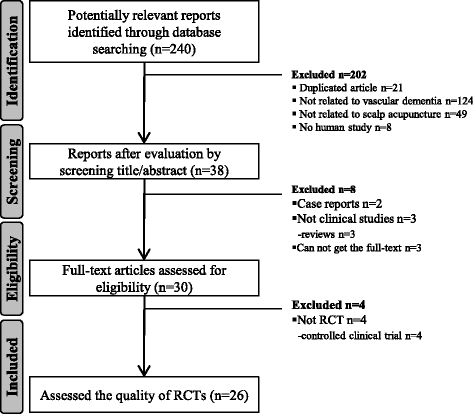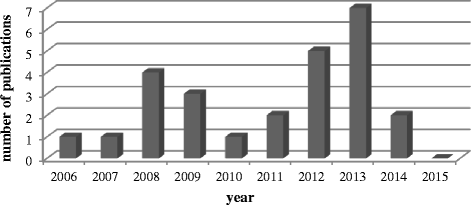Assessing the quality of reports about randomized controlled trials of scalp acupuncture treatment for vascular dementia
- PMID: 28464917
- PMCID: PMC5414371
- DOI: 10.1186/s13063-017-1945-0
Assessing the quality of reports about randomized controlled trials of scalp acupuncture treatment for vascular dementia
Abstract
Background: This study aimed to evaluate the quality of reports about randomized controlled trials (RCTs) of scalp acupuncture (SA) for the treatment of vascular dementia (VD).
Method: A systematic search of reports published through to December 2015 was performed in eight databases. The quality of RCTs that used SA as an intervention for VD was evaluated based on the 2010 Consolidated Standards for Reporting of Trials (CONSORT) and 2010 Standards for Reporting Interventions in Controlled Trials of Acupuncture (STRICTA) guidelines. Thirteen items from the CONSORT guideline were scored to give an overall quality score (OQS, range 0-13), and a combined key methodological index score (MIS) (range 0-5) of five key methodological items was measured. The OQS of 17 items from the STRICTA guideline (range 0-17) was also measured.
Results: In total, 26 reports were evaluated. The median OQS based on the CONSORT guideline was 8 (minimum 5, maximum 11), and "trial design," "sample size," "ancillary analyses," and "harms" had a positive rate of less than 10%. The median MIS was 2 (minimum 0, maximum 5), with "allocation concealment and implementation," "blinding," and "intent-to-treat analysis" having a positive rate of less than 15%. The median OQS based on the STRICTA guideline was 12 (minimum 8, maximum 14), with "extent to which treatment was varied (1c)," "number of needle insertions per subject per session (2a)," and "setting and context of treatment (4b)" having a positive rate of less than 10%.
Conclusions: The overall quality of reports on RCTs of SA treatment for VD was moderate to low. The quality of methodological items was markedly lower than that of other items. The CONSORT and STRICTA guidelines should be used more frequently to standardize the quality of RCT reports of SA treatment for VD.
Keywords: CONSORT; Randomized controlled trials; STRICTA; Scalp acupuncture; Vascular dementia.
Figures
References
-
- Murray ME, Knopman DS, Dickson DW. Vascular dementia: clinical, neuroradiologic and neuropathologic aspects. Panminerva Med. 2007;49:197–207. - PubMed
Publication types
MeSH terms
LinkOut - more resources
Full Text Sources
Other Literature Sources
Medical



